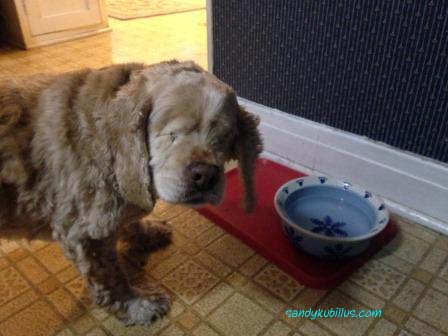When our pets become sick with chronic diarrhea, vomiting, or develop skin problems, they could be telling us that something is wrong with our environment. Do we listen? Not always, or not for long, because we have options. Our pets don’t—they rely on us for everything.
We buy premium pet food. Maybe we stop spraying our lawns with insecticides. Maybe we switch household cleaners to ones that are pet friendly.
But water? Maybe we switch our pet to bottled water for a while, but eventually switch back to tap water since it’s cheaper and more convenient. Our dogs are messy drinkers, often dropping saliva and dirt from their jowls into our expensive bottled water that we used in their water dish. It’s much easier to dump out that disgusting water dish and refill it from the tap.
How do you get your drinking water? From the kitchen tap? From filtered tap water? From a company that bottles water? What about your pets?

When my first dog developed epilepsy, I immediately switched her to bottled water. After all, my tap water had gone bad once before—sure that was a different house and a different community.
I know how it feels to let the water run while I am brushing my teeth and smell ethanol wafting up from the tap. It wasn’t just my house, it was the whole city. Runs on bottled water occurred back when grocery stores stocked very little. This was the mid-1980s, before bottled water became popular. The odor in the tap water made the local paper while the government denied any problem. It took months for it to clear up, and only then did the government admit that a mistake was made. Our drinking water is from Lake Michigan, but apparently an old intake valve was opened in the middle of the industrial harbor instead of the normal intake a mile out into the lake.
But I wonder about the lead in the pipes. I know we have a polyphosphate in the drinking water to prevent lead pipes from leaching lead into the water. I know this since I have tested the local tap water with a phosphorus kit that I have at my environmental consulting job.
But could Flint, Michigan with its drinking water problems come here? Flint, Michigan had its local tap water switched from Lake Huron to the Flint River in order to save money. The river water contained high levels of bacteria, which was treated with chlorine, but the water was very corrosive. To save more money, the government did not add polyphosphate and the lead pipes leached into the tap water causing thousands to get sick, especially the children. Lead had its greatest impact on developing children, especially on cognitive function. The government again misinformed the public for a long time and stated that the water was safe to drink. The community eventually was given bottled water.
But what about the pets?
What about living out in the country where people drink groundwater, which is supposed to be healthier since it isn’t supplemented with fluoride and chlorine. I recently read the story of Stacy Haney from Amity, Pennsylvania, in the Appalachian Mountains, a close-knit farming community. Her neighbors raised award-winning boxers and horses. The story starts with a puppy dying, and then a horse, and then a goat. One of the children gets sick, and then several adults. Fracking for natural gas had moved into their neighborhood, mining the Marcellus Shale for gas. “It’s safe,” Stacy was told, until more animals died and her water turned black. To ward off her fears, the gas company gave her a water tank, which stored about 200 gallon of water. But her animals continued to drink the tap water, coming from the ground and from natural springs, now polluted from a leaking fracking sludge pond uphill from her farm. Amity and Prosperity tells the story of Stacy and her fight for clean water, her fight against the fracking industry, and how big industry and government failed her. Something we are hearing about over and over again.
I highly recommend you read Amity and Prosperity and also to watch the
What kind of water does your pet drink?
My cocker spaniel, Buffy, is ten-years-old and drinks unfiltered tap water. She seems healthy—at least for now. I drink either bottled


What a thought-provoking post, Sandy. It us certainly frightening to think when we are tokd things something as typical as drinking a glass of water is “safe” when it is not and the powers that be know it! Shame! We are supposed to look out for each other. Always disturbing to hear of towns who have suffered the fate as Flint. I am fortunate that we have one if the water supplies in our state (so we have been told)…so it is drinkable. We do have a watter cooler also. On days when tap water is discolored from city flushing lines, it is the water cooler bottled water for all here, our dogs included of course. But every day tap is what they usually drink, as do we, as well as fill our pools and bathe. But it gives us pause…even every now and again I wonder about those safe water bottles, too…lacks of honesty has groomed us to be suspect. And maybe that caution is a good thing.
Excuse typos, please! In car using voice recorder! 🤦🏼♀️
I’ve gone back and forth with the bottled water thing, but I’ve settled for my well. I drink it and so do the cats. I had the water tested when we moved in, but I should probably re-test it.
Sadly, that is true. I remember a story of a woman whose cats kept getting cancer. One, after another, after another. With the third case, the veterinarian got suspicious … the woman also had cancer. I can’t remember whether it was water or something else but it was such a case as well.
I heard about this movie coming soon and will definitely watch. Honestly I’m not surprised that such injustices are happening in certain communities as we have seen many other instances of pollution or commercial farming happen in other areas as you described. Most times I take what the government has to say concerning keeping our food/water/medicine safe with a grain of salt because history shows many times over the public is often lied to. As for my sweet Dusty and Precious (who both have their angel wings now) I used to give them tap water however when I started drinking filtered water from my pitcher , they did too. It wasn’t hard for me to transition them. I think they ended up drinking more water as a result.
I should really give my cats bottled or filtered water on a regular basis. They drink from a filtered fountain, but it’s probably not sufficient enough. This was a great with some great information.
I drink water from the tap, have been doing it all my life and in whatever country I lived and am still going strong, I give the same to Layla and thank goodness she is fine. San Francisco has good water and I know that so feel very safe, if something changes I would change to bottled water automatically.
Very interesting post, and I like the perspective. I never thought about my pets’ illnesses as a reflection of something that could be an indication of a problem in my own environment. Although my dog loves to eat grass and I am conscious of the possibility that pesticides had been sprayed there. My animals get tap water, but when we were in Spain for a few months I was advised against that so they only drank bottled. You’ve definitely given me something to think about.